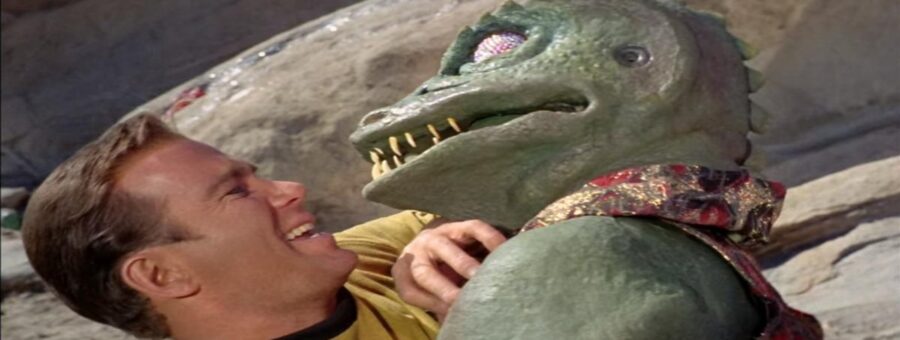How Star Trek Can Teach Us to Think Outside the Box

Shôn Ellerton, Mar 23, 2022
Watching Star Trek as a kid opened my mind more than any formal education in philosophy.
I’m sure someone, somewhere, and at sometime did some extensive research that anyone in their childhood that was raised up on a diet of the old original Star Trek episodes are better thinkers and uphold better moral principles than those who do not. To think heterodox and to think outside the box. Ooh, it’s a grand statement to make for sure but hear me out. But let’s turn the clock to TV back in my childhood first.
During my childhood in the US around the early 80s, the mainstay of afternoon TV was Leave It To Beaver, Little Rascals, The Six Million Dollar Man, I Dream of Jeannie, I Love Lucy, The Brady Bunch, Gilligan’s Island, and many more, some of which were undoubtedly very old heralding back to the late 40s. To be honest, most of it was average comfort viewing. Good boys and girls not to pick fights with anyone half your size. ‘Oh jeez, Mr Johnson! That was swell. I didn’t know you’re not supposed to fight with girls’ All respectable working parents must wear a suit at work while the wife cooks (in a dress!) while the man puts his feet up on the lounge table with a pipe. Cleaning, cooking, ironing? That’s woman’s work! Masculine shows with Lee Majors doing amazing things in a manly way along with his bionic powers, but with Wonder Woman, we need to have a ‘bit of leg’ to show off. As a man, I’m not complaining but I’m curious how many women watched Lee Majors and thought ‘I’d like a bit of that!’. It wasn’t so much to do with the 80s, but the fact that el cheapo TV broadcasting meant that re-runs and re-runs from the 40s, 50s and 60s made it so that most kids living in 80s USA, were brought up on these principles. Sure, some were good, but wow, how many of them are out-dated. And do I remember a single episode of any of them? I really cannot as most of them were quite unremarkable.
However, there were a few shows which stuck in my mind as being paradigms of timeless examples of upholding good morals and principles, even to the extent of teaching philosophy in a fun and entertaining way. The three shows I remember most vividly are Doctor Who (I remember Tom Baker the most), The Twilight Zone, and of course, Star Trek, the original ones with Spock, Kirk and the bargain basement effects. I remember virtually every episode in mesmerising detail, including the messages they were trying to deliver. There were a few duds but given the budget these producers had and the strict timelines, these shows were knocked out of the studios and into the TV sets of millions of viewers with astonishing success. Forget the cheap effects like foam boulders, wobbling spaceships, robots with rubber hoses purporting to be tentacles, and bendy walls. It just didn’t matter. It should always have been treated as theatre. The acting and the stories made their successes.
Star Trek dealt in a very positive way that mankind can evolve and adapt successfully in the known universe, provided certain principles and morals are upheld. Equally fascinating stories delivered by the Doctor Who writers concentrated more on the malfeasance of alien societies, some of which were very frightening and highly dictatorial; the Daleks, Cybermen and the Sun Makers (along with their nightmarish steam execution device) being great examples. Unlike Star Trek, it was more focussed on the acts of the Doctor and his small team of people to save the day rather than a collective in the guise of a galactic federation.
Star Trek had less in the way of monsters and beasts than Doctor Who, making it rather more human-focussed, and when they did have the occasional beast or two, they were usually comically funny like the green Gorn lizard-like man in the episode, Arena, who failed to squash Kirk’s head with a foam boulder in a fight orchestrated by a ‘more superior’ and ethereal form of intelligence or that of a defensive silicon-based lifeform portrayed by a moving foam rock by way of a couple of people shuffling under it in Devil In The Dark. They were great stories though and memorable with their messages. To this day, Star Trek was never interested in making a good monster or alien species, but preferred to continue sticking bits of plastic and rubber on people’s faces whereas Doctor Who made great effort in later years to churn out quite effective and frightening aliens like the Weeping Angels.
Twilight Zone was different again and focussed more on what if’s, opportunities lost, bad dreams, and other worldliness. They were more akin to the writings of Ray Bradbury and Roald Dahl. Walking around a town with no people. A man who wished he could be away from his wife and just to be left alone with his books only to find himself surviving some sort of apocalyptical event but revels in joy when he has the chance to read to his heart’s content in what’s left of the local library, that is, until he accidentally breaks his reading glasses. Wishing for more than you should at an obscure little magic trick shop; well we can see how that can go wrong. A man that suffers his own fate in the electric chair in a dream night after night. That sort of thing. It was, overall, quite dark, some being genuinely scary.
As for music and sound, all three shows had great title themes, but Star Trek had the edge with its background music and sound effects which the others lacked. That weird ethereal sound after the crew beams down to an alien planet. The haunting music, much of it with theremin sounding tones, during those slow passages of intrigue, for example, when mysterious, beautiful women with nefarious intentions are luring officers to a certain doom, much like the Sirens of Greek mythology. And of course, the exciting action score during the battle and fight scenes.
Star Trek TOS (the original series) was never meant to be really science fiction for me but more of a mixture of fantasy combined with a sort of Aesopian message and an intriguing storyline behind every episode. If Star Trek was to be taken as pure science fiction, I would have laughed at it and lost interest, and like some of the other hits of the time, including Space 1999, it would have been forgotten by most these days except for those who like the nostalgia of watching something they watched as a kid. Recently, I came across a few Battlestar Galactica episodes which I remember watching as a kid in the 80s. I watched one and yes, the enemy Cylons were kind of cool, but it was cringeworthy and terribly corny and I just had to turn it off. Star Trek is still as fresh as ever, especially the original series.
However, there were certain aspects of it one had to tune out. Some of my favourite examples are these. The convenient large wrench lying in wait to be used as a weapon in an otherwise completely tidy engine room. There are always fights in the engine room we generally tend to discover. Another example. Anything can be fixed on a starship by removing one of the panels on the bridge and shorting out a few circuits. Spock is particularly good at doing this. Of course, we have sexy skirts for the female crew, although I’m not complaining here. And my personal favourite. The use of rotating office leather chairs with basic car seat belts in the shuttlecraft, the use of I fail to understand considering that they have beam transports at their disposal. And yes, in case you’re thinking what I know you’re about to think about, there was an episode in which the beam transporter was working just fine!
But what has Star Trek taught us?
Quite a lot it seems.
Sure enough, some of the fictional technology became reality like the communicators and the biomed machines to some extent. But really, it’s about how to and how not to treat others in society. Netflix has recently been streaming all the original series in beautifully restored picture quality and I have been watching them with my young son, who has taken a great liking to the show and now often replies sarcastically to comments of knowledge by stating, ‘Fascinating’ in a dead-pan voice emulating Spock.
His favourite episode is Arena in which Kirk and pursues an alien starship operated by an alien lizard-like creature. Both starships are incapacitated, and the captains of each ship are beamed forcibly to some planet in which they battle out their differences with none of their weapons to hand. It turns out that they encroached into space controlled by a superior, gentle, and effeminate looking race called the Metrons who put them there to fight the other to death. The crew on each starship could only watch on their monitors being held in suspense who was going to survive. The surviving captain would return to his crew and ship unharmed, the other ship to be destroyed by the Metrons. They were both informed that there were materials in the area which could be used as a weapon. The Gorn was much stronger physically but Kirk worked out that, after finding deposits of sulphur, diamonds, charcoal, potassium nitrate along with a stash of thick bamboo tubes could make a convenient cannon in which to use to kill his opponent. The mechanics of doing so effectively is, in reality, quite fantastical; but Kirk did manage to shoot a load of diamonds into the Gorn which injured him terribly leaving Kirk with the chance of smashing his head in with a boulder. But he does not, demonstrating the value of mercy. The Metrons are impressed and let both ships and their captains go unharmed quipping that mankind has a chance after all.
Incidentally, when I was 12 or so, I was given a chemistry kit and, after watching this very same episode, made up the same concoction, put it in a jar under a large rock in the adjacent playground and lit a fuse in it. I had a supply of fuses because I was into rocket building. I ran for cover but disappointingly, it didn’t go BANG destroying the rock into smithereens but rather hissed violently leaving the rock heavily charred and burned. I was to later realise that I needed pressure and a bit of mercury fulminate to make this happen! Imparting this sort of knowledge to curious boys’ minds would be the cause of much alarm to most parents, but my mother knew nothing of what I was doing nor did she have any interest in Star Trek. But this a story for another occasion.
Apart from learning how to make gunpowder, there are too many examples of valuable messages to be taken away from watching Star Trek to be cited in one article but there was one other episode which still troubles me to this day and is one of my favourites, A Taste of Armageddon.
In this episode, the captain and a small consignment of officers find themselves, despite many warnings not to go there, beamed down on a civilised and highly developed planet seemingly untroubled by any sign of war. The story of this episode is both complex and intriguing not too dissimilar to something Kurt Vonnegut would have written in his repertoire of dystopian nightmares. Apparently, the world in which they beamed down to is in war with another planet for the best part of five hundred years or so, yet there is no visible sign of damage. Naturally, the Enterprise crew are confused and ask questions why this isn’t the case. The answer they were given is both logical and frightening at the same time. For centuries, war had been going based on computer predictions should a physical strike take place. Think of the 80s movie, War Games, a movie still fun to watch today. The discussion with the Enterprise crew was interrupted and Kirk was led into an operating room with a digital map on the wall in which a missile hit a part of the city. There was no explosion which, of course, confused Kirk even more. Indeed, it was pointed out that no damage had been done and that there was no missile at all.
However, the residents who lived in the area affected in the simulation were summoned to enter their local disintegration chambers, a device, which, I would assume very quickly and mercifully, kill anyone who enters it. In this society, everyone was brought up and raised to do so without question. This principle alone, is horrifying to the extent that certain narratives in the real world work this way as well. The idea by the designers of the system were, to some extent, logical, but utterly misguided. The idea of war without the aftermath of physical damage, disease, and famine. The designers, after all, were technocrats and scientists who saw the logic of this, but what they failed to see was the humanity and consequences of what they were doing and the horrifying legacy they were to leave behind. As a milder comparative in the real world, I’m thinking about the logic of implementing sustained lockdowns to kill off a virus but ignore the long-lasting effects of mental disorder, depression, and suicide.
What entailed was a lengthy war generation after generation without anyone ever thinking outside the box or great narrative that perhaps confronting the enemy physically and trying to enact some sort of diplomatic relationship might have ended the war centuries ago. After generations, no one in that society had the ability to think this way as it became so engrained into the mindset of its people. Kirk suggests that they switch off the computers; however, the designers had this in mind as well. Should the connection between warring computers be broken by any side, a physical war would be declared. A lesser known but excellent 70s cold war sci-fi movie called Colossus: The Forbin Project goes one step further when US and Soviet supercomputers connect to each other and then ‘conspire’ with each other to automatically launch ICBMs should human intervention arise to disconnect them. Kirk reacts in the strongest possible terms by destroying the computer with his phaser thus forcing each side to come quickly come to some sort of negotiation with the aid of the Federation to assist in opening communications between the planets. All this in a 45-minute episode as well. This episode, alone, should be watched by anyone interested in the principles of war and when scientists start making all the decisions in an emergency.
In essence, these are the sort of shows which our younger generation should be watching. They don’t have to be old Star Trek episodes, but I’ve not come across anything quite like them. For certain, our youngsters are not getting much substance from watching meaningless and short videos in the attention-deficit world of YouTube and more recently, TikTok. I am highly certain of that!


